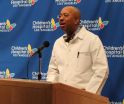Autism breakthrough: Researchers identify possible treatment for impaired sociability
Eastern Virginia Medical School moving toward small-scale clinical trial
2010-12-09
(Press-News.org) NORFOLK, Va. – Eastern Virginia Medical School researchers have identified a potential novel treatment strategy for the social impairment of people with Autism Spectrum Disorders (ASD), an aspect of the condition that has a profound impact on quality of life.
"Persons with Autism Spectrum Disorders are either disinterested in social interactions or find them unpleasant. They often don't understand what other people are thinking or feeling and misinterpret social cues," said Stephen I. Deutsch, MD, PhD, the Ann Robinson Chair and professor of psychiatry and behavioral sciences. "Sadly, persons with autism spectrum disorders are often painfully aware of their limited sociability, which can lead to profound feelings of sadness and frustration."
As part of their research, EVMS scientists verified that a specific mouse strain, known as the BALB/c mouse, is a valid animal model of the limited sociability seen in persons with ASD. In the presence of another mouse, BALB/c mice move as far away as possible and do not interact as normal mice do — just like people with autism often avoid making social contact with other people.
This finding gave researchers a way to test whether an existing medication can alter the function of certain receptors in the brain known to affect sociability and help the animals be more at ease around others. The medication used, D-Cycloserine, originally was developed to treat tuberculosis, but previous studies showed, by chance, that it might change social behavior. In preliminary studies at EVMS, the medication appeared to resolve the Balb/c mouse's deficits of sociability; it behaved as a normal mouse would when placed near another.
Dr. Deutsch will discuss the research at EVMS' Quarterly Autism Education Series at noon, Dec. 14, in the school's Hofheimer Hall auditorium.
EVMS' laboratory studies with the Balb/c mouse led its investigators to hypothesize that D-Cycloserine could ease the impaired sociability of persons with autism, such as avoiding eye contact and personal interaction. Those traits can severely limit the possibility of employment and independent living for someone with autism.
"What makes this important is you might have someone with a 125 or 130 IQ who's unemployable" because of their social impairments, said Maria R. Urbano, MD, associate professor of psychiatry and behavioral sciences.
Dr. Urbano is moving this promising research from the laboratory directly to patient care by starting a pilot clinical trial of D-Cycloserine in adolescent and young adult patients with autism spectrum disorders. The trial will show whether the medication, which is already known to be safe for use in humans, has similar effects on the sociability deficits of persons with autism as it did in the mice. Her research is supported by a grant from the Hampton Roads Community Foundation.
INFORMATION:
Published research studies:
"D-serine improves dimensions of the sociability deficit of the genetically-inbred Balb/c mouse strain"
http://www.ncbi.nlm.nih.gov/pubmed/21056638
"D-Cycloserine improves the impaired sociability of the Balb/c mouse"
http://www.ncbi.nlm.nih.gov/pubmed/20970484
"Locomotor activity of the genetically inbred Balb/c mouse strain is suppressed by a socially salient stimulus"
http://www.ncbi.nlm.nih.gov/pubmed/20637841
About EVMS:
EVMS was founded by the community in 1973 to improve health through teaching, discovering and caring. The collaborative culture at EVMS draws like-minded students and faculty from all over the country, encourages a multidisciplinary approach to health care and emphasizes translational research. In just 36 years, the school has grown from 24 students to an economic footprint exceeding $700 million annually in the region of southeastern Virginia known as Hampton Roads. Learn more at www.evms.edu.
ELSE PRESS RELEASES FROM THIS DATE:
2010-12-09
WASHINGTON, Dec. 8 – Versatile electronic gadgets should employ a number of important criteria: small in size, quick in operation, inexpensive to fabricate, and deliver high precision output. A new microlaser, developed at the Jožef Stefan Institute in Ljubljana, Slovenia embodies all these qualities. It is small, tunable, cheap, and is essentially the world's first practical three-dimensional laser.
As described in Optics Express, an open-access journal published by the Optical Society (OSA), Slovenian scientists Matjaž Humar and Igor Muševič have developed a microdroplet ...
2010-12-09
A peculiar gas-giant planet orbiting a sun-like star 1200 light-years away is the first carbon-rich world ever observed.
The implications are big for planetary chemistry, because without much oxygen, common rocks throughout the planet would be made of pure carbon, in forms such as diamonds or graphite.
"On most planets, oxygen is abundant. It makes rocks such as quartz and gases such as carbon dioxide," said University of Central Florida professor Joseph Harrington, one of the study's lead researchers. "With more carbon than oxygen, you would get rocks of pure carbon, ...
2010-12-09
Sudden changes in the volume of meltwater contribute more to the acceleration – and eventual loss – of the Greenland ice sheet than the gradual increase of temperature, according to a University of British Columbia study.
The ice sheet consists of layers of compressed snow and covers roughly 80 per cent of the surface of Greenland. Since the 1990s, it has been documented to be losing approximately 100 billion tonnes of ice per year – a process that most scientists agree is accelerating, but has been poorly understood. Some of the loss has been attributed to accelerated ...
2010-12-09
An international team of astronomers has discovered and imaged a fourth giant planet outside our solar system, a discovery that further strengthens the remarkable resemblances between a distant planetary system and our own.
The research is published Dec. 8 in the advance online version of the journal Nature.
The astronomers say the planetary system resembles a supersized version of our solar system.
"Besides having four giant planets, both systems also contain two 'debris belts' composed of small rocky or icy objects, along with lots of tiny dust particles," ...
2010-12-09
LOS ANGELES (December 8, 2010) – Jeffrey S. Upperman, MD, director of the Trauma Program at Children's Hospital Los Angeles, has co-authored a call to action for filling a significant gap in pediatric public health care and seeks federal oversight to establish the framework for a pediatric applied trauma research network (PATRN). This call to action was published simultaneously in the Journal of Pediatric Surgery and the Journal of Trauma.
"The establishment of a pediatric trauma research network will be an important advance in trauma care in the U.S.," said Dr. Upperman. ...
2010-12-09
Drinking cranberry juice has been recommended to decrease the incidence of urinary tract infections, based on observational studies and a few small clinical trials. However, a new study published in the January 1 issue of Clinical Infectious Diseases, and now available online (http://cid.oxfordjournals.org/content/52/1/23.full), suggests otherwise.
College-aged women who tested positive for having a urinary tract infection were assigned to drink eight ounces of cranberry juice or a placebo twice a day for either six months or until a recurrence of a urinary tract infection, ...
2010-12-09
Diving blue whales can dive for anything up to 15 minutes. However, Bob Shadwick from the University of British Columbia, Canada, explains that blue whales may be able to dive for longer, because of the colossal oxygen supplies they could carry in their blood and muscles, so why don't they? 'The theory was that what they are doing under water must use a lot of energy,' says Shadwick. Explaining that the whales feed by lunging repeatedly through deep shoals of krill, engulfing their own body weight in water before filtering out the nutritious crustaceans, Shadwick says, ...
2010-12-09
BLOOMINGTON, Ind. -- A new study by sexual health researchers at Indiana University found that women who used lubricant during sex reported significantly higher levels of satisfaction and pleasure.
The study, involving 2,453 women, is the largest systematic study of this kind, despite the widespread commercial availability of lubricant and the gaps in knowledge concerning its role in alleviating pain or contributing to other health issues.
"In spite of the widespread availability of lubricants in stores and on the Internet, it is striking how little research addresses ...
2010-12-09
CAMBRIDGE, Mass., Dec. 9, 2010 -- The centuries-old "one-drop rule" assigning minority status to mixed-race individuals appears to live on in our modern-day perception and categorization of people like Barack Obama, Tiger Woods, and Halle Berry.
So say Harvard University psychologists, who've found that we still tend to see biracials not as equal members of both parent groups, but as belonging more to their minority parent group. Their research appears in the Journal of Personality and Social Psychology.
"Many commentators have argued that the election of Barack Obama, ...
2010-12-09
SAN DIEGO – (December 9, 2010) – A La Jolla Institute team, led by leading type 1 diabetes researcher Matthias von Herrath, M.D., has demonstrated the effectiveness of a recently developed computer model in predicting key information about nasal insulin treatment regimens in type 1 (juvenile) diabetes. Development of the software, the Type 1 Diabetes PhysioLab® Platform, was funded through the peer-reviewed grant program of the American Diabetes Association.
The findings, which also showed the platform's ability to predict critical type 1 diabetes molecular "biomarkers," ...
LAST 30 PRESS RELEASES:
[Press-News.org] Autism breakthrough: Researchers identify possible treatment for impaired sociability
Eastern Virginia Medical School moving toward small-scale clinical trial

